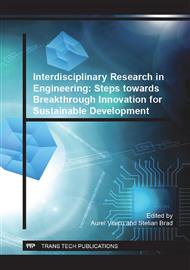[1]
M. Moretti, T.P. Tassios, Behaviour of short columns subjected to cyclic shear displacements: Experimental results, Eng Struct, 29 (2007) 2018-(2029).
DOI: 10.1016/j.engstruct.2006.11.001
Google Scholar
[2]
E. Vintzileou, T.P. Tassios, M. Chronopoulos, Experimental validation of seismic code provisions for RC columns, Eng Struct, 29 (2007) 1153-1164.
DOI: 10.1016/j.engstruct.2006.08.013
Google Scholar
[3]
Information on http: /nisee. berkeley. edu/taiwan/mahin/index. html.
Google Scholar
[4]
Information on http: /www. nexus. globalquakemodel. org/gem-building-taxonomy/overview/glossary/short-column.
Google Scholar
[5]
G. Campione, M. Fossetti, M. Papia, Behavior of Fiber-Reinforced Concrete Columns under Axially and Eccentrically Compressive Loads, Aci Struct J, 107 (2010) 272-281.
DOI: 10.14359/51663692
Google Scholar
[6]
G. Campione, G. Minafo, Compressive behavior of short high-strength concrete columns, Eng Struct, 32 (2010) 2755-2766.
DOI: 10.1016/j.engstruct.2010.04.045
Google Scholar
[7]
E. Vintzileou, A. Stathatos, Assessment of the seismic behaviour of RC columns, Eng Struct, 29 (2007) 1296-1311.
DOI: 10.1016/j.engstruct.2006.07.002
Google Scholar
[8]
M.H. Harajli, Bond strengthening of lap spliced reinforcement using external FRP jackets: An effective technique for seismic retrofit of rectangular or circular RC columns, Constr Build Mater, 23 (2009) 1265-1278.
DOI: 10.1016/j.conbuildmat.2008.07.028
Google Scholar
[9]
O. Ozcan, B. Binici, G. Ozcebe, Seismic strengthening of rectangular reinforced concrete columns using fiber reinforced polymers, Eng Struct, 32 (2010) 964-973.
DOI: 10.1016/j.engstruct.2009.12.021
Google Scholar
[10]
M. Mouli, H. Khelafi, Strength of short composite rectangular hollow section columns filled with lightweight aggregate concrete, Eng Struct, 29 (2007) 1791-1797.
DOI: 10.1016/j.engstruct.2006.10.003
Google Scholar
[11]
A. Momayez, M.R. Ehsani, A.A. Ramezanianpour, H. Rajaie, Comparison of methods for evaluating bond strength between concrete substrate and repair materials, Cement Concrete Res, 35 (2005) 748-757.
DOI: 10.1016/j.cemconres.2004.05.027
Google Scholar
[12]
F. Qiao, C.K. Chau, Z.J. Li, Property evaluation of magnesium phosphate cement mortar as patch repair material, Constr Build Mater, 24 (2010) 695-700.
DOI: 10.1016/j.conbuildmat.2009.10.039
Google Scholar
[13]
I.O. Toma, G. Taranu, A.M. Toma, M. Budescu, Influence of cement and sand type on the strength characteristics of mortars with various contents of green binder, Procedia Engineer, 21 (2011) 196-203.
DOI: 10.1016/j.proeng.2011.11.2004
Google Scholar
[14]
I.O. Toma, D. Covatariu, G. Taranu, M. Budescu, Early-age mechanical properties of mortars with different percentages of eco-cement, Bulletin of The Polytechnic Institute of Jassy - Construction Architecture Section, LVII (LXI) (2011) 155-166.
Google Scholar
[15]
D. Palermo, F.J. Vecchio, Simulation of cyclically loaded concrete structures based on the finite-element method, J Struct Eng-Asce, 133 (2007) 728-738.
DOI: 10.1061/(asce)0733-9445(2007)133:5(728)
Google Scholar
[16]
U. Kim, R.T. Leon, T.V. Galambos, 3-D nonlinear dynamic behavior of steel joist girder structures, Eng Struct, 31 (2009) 268-274.
DOI: 10.1016/j.engstruct.2008.08.018
Google Scholar
[17]
S. Grange, P. Kotronis, J. Mazars, Numerical modelling of the seismic behaviour of a 7-story building: NEES benchmark, Mater Struct, 42 (2009) 1433-1442.
DOI: 10.1617/s11527-008-9462-y
Google Scholar
[18]
I.O. Toma, T. Kimura, K. Watanabe, J. Niwa, Shear Failure of Short Cantilever RC Columns under Cyclic Loading: Experiments and Analysis, in: Proceedings of 5th International Conference on Urban Earthquale Engineering, Tokyo, Japan, 2008, pp.227-233.
Google Scholar
[19]
JIS A 1108: 2006 - Method of test for compressive strength of concrete, in, Japanese Industrial Standard, (2006).
Google Scholar
[20]
J.S. Damtoft, J. Lukasik, D. Herfort, D. Sorrentino, E.M. Gartner, Sustainable development and climate change initiatives, Cement Concrete Res, 38 (2008) 115-127.
DOI: 10.1016/j.cemconres.2007.09.008
Google Scholar
[21]
G. Spaargaren, A.P.J. Mol, Greening global consumption: Redefining politics and authority, Global Environ Chang, 18 (2008) 350-359.
DOI: 10.1016/j.gloenvcha.2008.04.010
Google Scholar
[22]
J.K. Hall, G.A. Daneke, M.J. Lenox, Sustainable development and entrepreneurship: Past contributions and future directions, J Bus Venturing, 25 (2010) 439-448.
DOI: 10.1016/j.jbusvent.2010.01.002
Google Scholar
[23]
M. Garg, A.K. Minocha, N. Jain, Environment hazard mitigation of waste gypsum and chalk: Use in construction materials, Constr Build Mater, 25 (2011) 944-949.
DOI: 10.1016/j.conbuildmat.2010.06.088
Google Scholar
[24]
I.O. Toma, D. Covatariu, A.M. Toma, G. Taranu, M. Budescu, Greening of Concrete Industry by Incorporating Gypsum-Based Industrial Wastes as Supplementary Cementitious Materials, Advanced Materials Research, 649 (2013) 246-249.
DOI: 10.4028/www.scientific.net/amr.649.246
Google Scholar
[25]
F. Sajedi, H.A. Razak, Effects of curing regimes and cement fineness on the compressive strength of ordinary Portland cement mortars, Constr Build Mater, 25 (2011) 2036-(2045).
DOI: 10.1016/j.conbuildmat.2010.11.043
Google Scholar
[26]
A. Itim, K. Ezziane, E.H. Kadri, Compressive strength and shrinkage of mortar containing various amounts of mineral additions, Constr Build Mater, 25 (2011) 3603-3609.
DOI: 10.1016/j.conbuildmat.2011.03.055
Google Scholar
[27]
ASTM C469 / C469M - Standard Test Method for Static Modulus of Elasticity and Poisson's Ratio of Concrete in Compression, American Society for Testing and Materials, (2010).
Google Scholar
[28]
C.S.I., SAP2000 - Integrated Software for Structural Analysis & Design, Computers and Structures Inc, Berkeley, California, USA, http: /www. csiberkeley. com/sap2000/overview, (2011).
Google Scholar
[29]
M.M. Karthik, J.B. Mander, Stress-Block Parameters for Unconfined and Confined Concrete Based on a Unified Stress-Strain Model, J Struct Eng-Asce, 137 (2011) 270-273.
DOI: 10.1061/(asce)st.1943-541x.0000294
Google Scholar
[30]
J.B. Mander, M.J.N. Priestley, R. Park, Theoretical stress–strain model for confined concrete, J Struct Eng ASCE, 114 (1988) 1804-1826.
DOI: 10.1061/(asce)0733-9445(1988)114:8(1804)
Google Scholar
[31]
A.D. Espeche, J. Leon, Estimation of bond strength envelopes for old-to-new concrete interfaces based on a cylinder splitting test, Constr Build Mater, 25 (2011) 1222-1235.
DOI: 10.1016/j.conbuildmat.2010.09.032
Google Scholar
[32]
G. Taranu, I.O. Toma, R. Plesu, I. Gradinariu, M. Budescu, Experimental Evaluation of Elastic Modulus of Unreinforced and Glass Fibre Reinforced Mineral Matrix Composite, Proceedings of ICEUBI2011 - International Conference on Engineering, Covilha, Portugal, (2011).
Google Scholar
[33]
G. Taranu, M. Budescu, R. Plesu, I.O. Toma, A New Building System Made of Glass Fiber Reinforced Mineral Matrix Composites, Advanced Materials Research, 649 (2013) 25-28.
DOI: 10.4028/www.scientific.net/amr.649.25
Google Scholar


